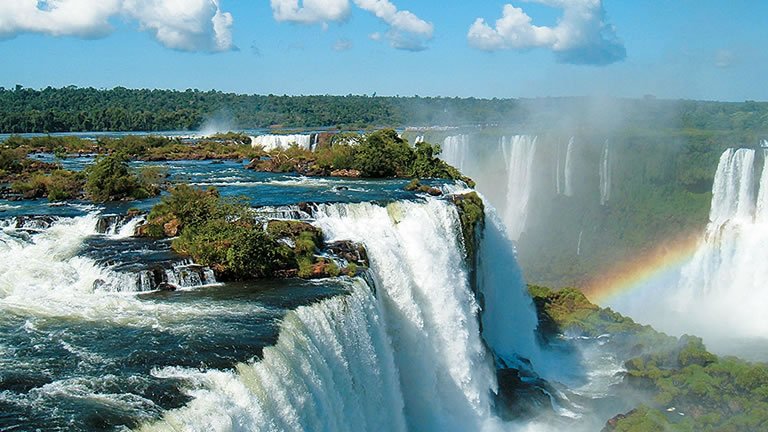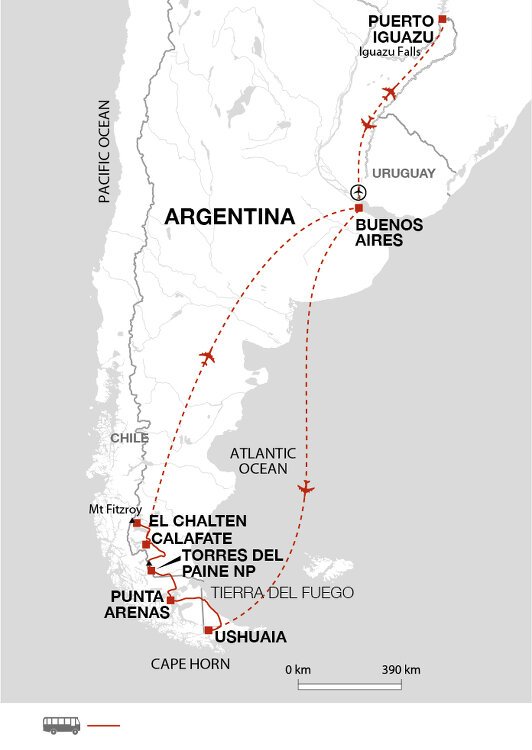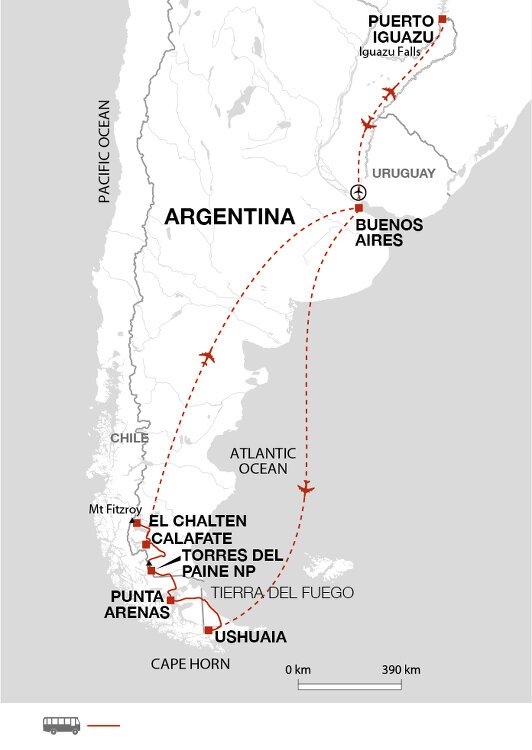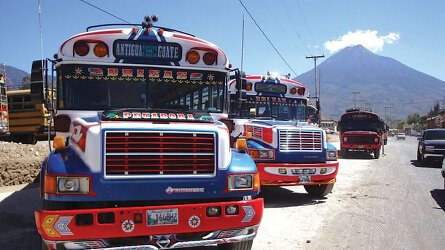Adventures in Patagonia with Iguazu Extension
Adventures in Patagonia with Iguazu Extension
Overview
Perito Moreno Glacier - This magnificent glacier showcases the might of nature; get closer with an optional boat trip or a hike on the ice itself
Torres del Paine - Walk among the...read more glacial lakes and mountain ranges of this immense national park
Buenos Aires - Explore Argentina's diverse capital, including tango-filled La Boca, and the arty San Telmo district.
Itinerary
Arrive in Buenos Aires, Argentina's capital, located on the southern shores of the Rio de la Plata. Since its founding by Pedro de Mendoza in 1536 the city has thrived on trade and its vibrant streets are filled with an eclectic mix of European architectural styles, with Spanish, French and Italian classicism rubbing shoulders with remnants of Victorian grandeur.
For those arriving on time our Leader plans to meet you in the hotel reception at 6pm for the welcome meeting and for those that wish, there is the chance to go out for dinner. There are no activities planned today, so you are free to arrive in Buenos Aires at any time. If you would like an airport transfer today, you'll need to arrive into either Aeroparque Internacional Jorge Newbery (AEP) or Ezeiza International Airport (EZE), a 30 minute or 1 hour drive respectively from our hotel. Should you miss the meeting, your leader will inform you of any essential information as soon as you catch up.
If your flight arrives earlier in the day, you could explore this lively city by wandering the streets of the arty San Telmo district, admiring the impressive architecture and relaxing parks in Palermo, or enjoying the traditional Porteno pastime of people watching from the many sidewalk cafes. Stay: Hotel Principado (Comfortable)
We're experiencing the city as a Porteno (a Buenos Aires native) today, using the local buses and exploring on foot. Each neighbourhood of Buenos Aires has a distinct character, with grand Italianate architecture rubbing shoulders with winding cobbled streets or tree-lined avenues. To get a feel for the heart of the city, we'll stroll towards its founding point at the Plaza de Mayo, where the President's dusty-pink mansion is located. Every big event in Buenos Aires's history has been witnessed by the Plaza, from the continued protests of the 'Madres de la Plaza de Mayo', going back to Eva Peron's mass demonstrations in 1945. From here, we hop on a bus towards the colourful vibrancy of La Boca. Settled originally by Italian migrants, the area is famed for its bright houses, a ramshackle affair of corrugated iron, and the tango dancers who perform in the streets. We'll visit a local 'cafecito' during our tour, taking a traditional Porteno elevenses of coffee and pastries.
We end our morning in bohemian San Telmo, with its small one-way streets, historic mansions and walls covered with street art. Our Tour Leader will suggest lunch at a traditional 'Bodegon', sampling items that an Argentinian grandma would be happy with. Empanadas, locro (corn and pumpkin stew) or choripan (a fat chorizo sausage in bread, with chimichurri sauce) may be on the menu as well as other local specialties.
The afternoon is free to explore, with much on offer. You could stay and explore San Telmo, which is particularly interesting when the antiques market takes over the cobbled streets. Or visit Recoleta Cemetery, the final resting place of Argentine luminaries, including Eva Peron. For book lovers, the Ateneo Grand Splendid, set in a converted theatre, is one of the most impressive bookstores in the world. This evening we have an opportunity to enjoy something of Buenos Aires' nightlife, perhaps going to a tango show and soaking up the pulsating rhythms of this most Latin of dances. Stay: Hotel Principado (Comfortable) (B)
Today we transfer to the airport for the flight to Ushuaia, the world's southernmost city, spectacularly located on the Island of Tierra del Fuego at the very tip of the South American continent. Beyond this remote port lies the Beagle Channel and then the open waters of The Drake Passage, where the deep rich waters of the Atlantic and Pacific Oceans converge amidst some of the most challenging seas on earth. This afternoon is free to explore the city as you choose. You may wish to stay on land, visiting what was once the old prison of Ushuaia, now the Maritime Museum and an excellent portrait of the harsh realities of life on these unforgiving oceans.
Alternatively, there are three different trips around the coast that allow you to get closer to the awesome nature in this part of the world:
1. Beagle Channel catamaran and penguin spotting. This five-hour option sees you taking a catamaran boat from Ushuaia through the Beagle Channel, cruising around Sea Lion Island, Bird Island, Les Eclaireurs Lighthouse and Martillo Island. During the trip we'll try to spot spot sea lions and cormorants and other diverse wildlife. At Isla Martillo the catamaran approaches the beach to see the Magellanic Penguin colony - note that on this trip there are no landings, but it's a great overview of the incredible scenery in the Beagle Channel.
2. Harberton Estancia and Isla Martillo. This six-hour excursion starts with a 90 minute drive to the Harberton Estancia, the oldest ranch in the Tierra del Fuego that dates back to the late 1800s. If the Estancia is open, you have the option of visiting the small museum inside for an additional fee, payable locally. The main reason for our trip here is to access the pier, which is the launching point for boats travelling to Isla Martillo - an island just 15 minutes offshore, home to a large penguin colony. This excursion is run by the only company permitted to let visitors disembark and walk among the penguins. Magellanic penguins are the largest colony, but you may also see Gentoo penguins or King Emperor penguins. Taking an hour-long walk around the island with a guide, you'll discover these colonies before the 15 minute return boat ride and 90 minute drive back to Ushuaia.
3. Beagle Channel boat to Sea Lion island and Bird Island. This last boat trip doesn't take you out to see the penguins, sailing just around the sea lion island and bird island. For those on a budget who may have seen penguins in other places, this is a great option to bring to life the area's wildlife and the bleak scenery of the Beagle Channel.
All excursions here in Ushuaia should be pre-booked before departure, preferably a minimum of three months prior to your trip. We cannot guarantee the availability of any of these excursions at any point.
Important note: flight schedules in Argentina change constantly. You may depart in the very early hours for your internal flight, and if so breakfast will be taken in flight rather than at the hotel. Alternatively, you may have a longer morning in Buenos Aires and depart in the late afternoon. Due to the changing nature of the flights, boat excursions may take place either on today's free afternoon, or on tomorrow's free afternoon on Day 4 of the trip. Stay: Villa Brescia Hotel (Comfortable) (B)
Tierra del Fuego translates as the Land of Fires and today we have time to explore the nearby national park. Separated from Patagonia by the waters of the Magellan Strait, Tierra del Fuego is a landscape of lakes, forest and tundra, set beneath an imposing backdrop of ragged mountain peaks. This morning we take a leisurely walk along a forest trail to Lapataia Bay, taking in the expansive views and hopefully coming across some of the abundant wildlife in the area. These peaks and valleys, filled with Lenga and Guindo trees which provide a rich haven for Patagonian grey foxes and condors. After lunch we return to Ushuaia and have a free afternoon to further explore the area.
Due to the flight schedules, the optional excursions offered on Day 3 might take place this afternoon instead. This will be advised to you locally in Argentina. Stay: Villa Brescia Hotel (Comfortable) (B)
After breakfast this morning we depart by public bus and spend our day travelling across Tierra del Fuego, crossing the Magellan Strait by ferry and entering Chile, to complete our journey to Punta Arenas later this afternoon. The journey takes approximately 10 hours including the ferry crossing and the border control (fruit and nuts cannot be taken into Chile - a small but important note if you like travelling with these snacks!). One of the largest maritime settlements in the region and the first Chilean settlement along the waters of the Magellan Strait, Punta Arenas was founded in the mid 19th century, beginning its life as a penal colony and growing rich on sheep ranching and (before the opening of the Panama Canal) the vital facilities that it offered to shipping traversing the dangerous routes through the southern oceans. Tonight we will have a chance to enjoy some local specialities, such as king crab, and perhaps sampling some of the excellent Chilean wines before retiring for the evening. Stay: Hotel Isla Rey Jorge (Comfortable) (B)
A landscape of rugged mountains, turquoise coloured glacial lakes and spectacular wildlife, the majestic vistas of Chilean Patagonia are some of the most scenic and environmentally diverse regions on the planet. Travelling north across the Patagonian steppe, with it's desolate rolling plains and views of the peaks of the Cordillera in the distance, we head first for the city of Puerto Natales, our gateway into the sumptuous landscapes of the Torres del Paine National Park. Founded in 1911 this southerly coastal town is a shipping port and a transport hub for almost everyone heading for the Paine Park and in fine weather the cafes are filled with travellers and crowds gathering for the big event - the arrival of the Navimag boat from Puerto Montt. After a brief stop in the town we continue towards the magnificent landscapes of the park, surely one of the most beautiful natural vistas on earth and a place once described by Alberto de Agostini as one of the most spectacular sights that the human imagination can conceive. Blessed with an abundance of natural wonders, the 934 square miles of land was turned into national park in 1959 and takes its name from the Tehuelche Indian word payne meaning blue, apt acknowledgment of the striking turquoise lakes that abound in this astonishing place. Our dramatic drive takes us via the Milodon Cave to our accommodation in Torres del Paine. Stay: Cabanas Del Paine Hotel (Comfortable) (B/D)
Included in the trip is a full day of fairly easy hiking and lookout points, as we don our walking boots and take on a comfortable 8km wildlife hike from Lake Sarmiento to the Laguna Amarga. At first, the area seems barren but it is home to a wide variety of flora and fauna. It's not unusual to see large numbers of guanacos here, as well as black-necked swans, upland geese and pink flamingos. We may even be fortunate enough to spot condors, or even the elusive puma. There are also more than 20 sites of ancient cliff paintings approximately 6000 years old along the trail. We continue by vehicle to the Cascada Paine, a stunningly situated falls under the backdrop of the jagged peaks of the Torres. From here, we continue to drive to the Blue Lagoon, where we stroll around the beach to admire the Towers from the same view that inspired Lady Florence Dixie to call them 'Cleopatra's needles' in her book Across Patagonia in 1880.
For those who prefer something more challenging, you have the option of undertaking the 22km trek to the base of the Torres del Paine. The entire hike is full of breath-taking panoramas as you cross glacial lakes, passing through river valleys and mountain forest, culminating in one of the most impressive lookouts in the park, over the spectacular Torres - imposing pinnacles of sharp granite that rise up over 2600m to pierce the sky. The total ascent and descent of the hike is 950m, taking us from a starting altitude of 30m to the peak of 980m, over approximately ten hours of walking time. The terrain is hilly, with mainly small and undulating slopes until the last kilometre, which is a steep push to the top.
If you would like to undertake this trek, your local guide will need to know by day 2 of the trip, in order to ensure that a guide is in place for you. Please also note that the Torres hike is not included, whereas the day exploration is. Stay: Cabanas Del Paine Hotel (Comfortable) (B/D)
On our second day in Torres del Paine, we will start the day with a visit to a viewpoint where we will enjoy stunning panoramas of Lake Pehoe. Next, we will head to Mirador Cuernos where we will see views of the Valle del Frances (approximately 2 hours walk). In the afternoon, there is the opportunity to take an optional zodiac trip on the Serrano River to witness the Serrano Glacier. For those not interested in the boat trip, other options include walking to the Claudio Lagoon or to the Nuria river. (both walks are approximately 2 hours). Stay: Cabanas Del Paine Hotel (Comfortable) (B/D)
After breakfast we depart for the Argentinean border at Cerro Castillo, crossing the vastness of an empty, treeless plateau, where the only signs of life are the occasional estancia sheltering behind a windbreak of rare trees. Our destination is Calafate, situated on the southern shores of Lago Argentino, an unassuming little community that has been declared the national capital of the glacier region and the gateway to Los Glaciares National Park (approximately 6 hours drive). Stay: Hotel Quijote (Comfortable) (B)
Today we have a full day visit to the awe-inspiring Perito Mereno Glacier, a highlight which ranks as one of South America's most magnificent sights and arguably one of the world's greatest spectacles. Fed by the vast expanse of the Southern Patagonian Ice Field, the glacier covers some 250 sq km and presents us with an impressive list of statistics. It stretches of over 30km and at its deepest point is over 700m thick. It is advancing at a rate of 700 metres per year, but is estimated to calve off great chunks at probably the same rate, meaning that it has remained pretty much stationary for nearly a century. All in all it is a natural masterpiece of quite spectacular majesty. Whilst at the glacier, there will be the chance to either trek on the ice (an age limit of 65 years applies due to National Park regulations) or take a boat ride to get closer to the glacier face.
Note that the ice trek is very popular, and for those interested we advise pre-booking your spot with us before you travel to avoid disappointment. It involves a walk on the ice itself, with crampons. No experience is necessary, and you'll have a little time to practice walking with crampons before getting on the glacier. The walk is not strenuous - while there are some very light inclines, the pace is slow and steady. The terrain is uneven, however, with seracs and glacial pools that the expert guides will help you to navigate. Stay: Hotel Quijote (Comfortable) (B)
Today we drive to the picturesque town of Chalten (approximately 3 hours), lying at the confluence of the De las Vueltas and Fitzroy Rivers in Los Glaciares National Park. Arriving at approximately 11am we will have lunch before checking in, and the afternoon is free to explore the town and its surrounding trails. You will have the option to visit the Huemul reservation, a private pristine reserve 16kms from Chalten, with numerous trails to explore. Although you don't get the spectacular views that you have come to expect from Torres, the park is beautiful in its solitude and is home to a diverse number of species including condors, foxes and the magellanic woodpecker. Alternatively you may wish to take a trip to Lago Del Desierto; during this 8 hour trip you will enjoy a scenic drive to the lake, followed by a short sail across the lake and a hike up to the Vespignani Glacier lookout. Stay: Pudu Lodge (Comfortable) (B)
Over the next day and a half, we have the opportunity to explore the stunning Fitz Roy Massif. Today we set out with a local guide, weather permitting, to cover the distance to the base of Mount Fitz Roy, whose unmistakable summit is almost permanently covered in cloud, a phenomenon that was believed to be smoke by the indigenous Tehuelche who named it Chalten (smoky mountain). The mountain reaches a height of some 3405m (although our aim is to reach the base at around 1200m), and its forests and slopes are home to a unique array of wildlife, including the elusive huemel, a small deer and the majestic (and far from small) condor, one of the largest land birds on the planet. The scale and grandeur of this setting, where the glaciers seem to hang suspended between the jagged peaks, makes this walk a truly rewarding excursion.
The hike is on a well-marked trail covering a variety of terrain, from atmospheric forest and flowing rivers to open mountain scenery. Our total ascent and descent is approximately 730m, over a distance of 22km. This return journey will take us some 8-9 hours.
This walk is challenging due to the distance covered. There are other shorter walks available on self-guided trails should you prefer, or you may take the time instead to relax around the town of Chalten and its stunning surrounds. Stay: Pudu Lodge (Comfortable) (B)
We have a three hour drive back to Calafate this morning, in time for our afternoon flight to Buenos Aires. For those who wish there may be the opportunity to take in one of the city's famous tango shows.
Please note that there are frequent airline schedule changes on domestic flights in Argentina. The flight back to Buenos Aires may arrive in the late evening, giving you the morning free in Patagonia. Stay: Hotel Principado (Comfortable) (B)
Driving back to the airport you will fly (unescorted) to Puerto Iguazu (Argentina), where you will be met by a local guide. During your time here you will get the chance to visit the Brazilian and Argentinean sides of the falls, to witness for yourselves what are arguably the most beautiful waterfalls on the planet. Set amidst the lush landscapes of the Parque Nacional do Iguazú Reserve, the falls are one of nature's true masterpieces, a spectacular cascade of some 275 interconnecting falls that hurtle over high cliffs into a marvellous curved amphitheatre- a breathtaking sight that extends 3km across the Rio Iguazu. Viewed from the Brazilian side the Falls present themselves in all their majestic and powerful glory and the noise is tremendous, with huge clouds of soaking mist being churned up by the cascade. The national park was declared a World Heritage Site in 1986 and its trails are a paradise for nature lovers, the surrounding spray-soaked forest providing a rich haven for some spectacular flora and fauna, with over 2,000 plant species and over 400 different types of birds being recorded here, as well as countless mammals, insects and reptiles. The canopy meanwhile is alive with a rich array of brightly plumaged toucans, parrots, humming birds and colourful butterflies, whilst the forest floor boasts jaguars, mountain lions, tapirs and capuchin monkeys.
Depending on the flight schedules, today's plan is to drive to the Brazilian side of the falls at Foz do Iguacu. Passing first by the visitor centre, we board the park's shuttle bus to reach the start of the wooden walkways. The panoramic view from the Brazilian side is excellent, and the walkways pass by a variety of viewpoints that culminate at the Devil's Throat. We may move this trip (approximately three-four hours) to the morning of Day 16 depending on the flight schedules.
Please note that the days in Iguazu are designed as an extension to our Adventures in Patagonia tour, and some of your fellow group members may leave the tour today in Buenos Aires before you fly to Iguazu. Whilst the extension has been designed to complement the Patagonia trip, we wish to point out that there may not be other Explore customers travelling with you. However, your transfers and excursions in Iguazu are not private and may be shared with others who are not booked through Explore. Stay: Hotel Saint George (Comfortable) (B)
From the Argentinean side of the Falls you can see a very different perspective of this incredible cascade, with the added bonus of generally fewer tourists. A guided transfer takes you to the gateway of the Iguazu National Park, where there is a visitor centre for you to explore at your leisure. You then have the option to walk the Sendero Verde (Green Trail) or take an open-top 'train' to the falls. The upper trail offers canopy views of the surrounding jungle, while the lower trail takes in views from below, and at times almost inside, the falls. The Devil's Throat viewpoint is also visible here at the Argentinean side, where 14 impressive cascades merge to form one of the most impressive views in the park. Stay: Hotel Saint George (Comfortable) (B)
This morning is left free to relax at the hotel before your flight back to Buenos Aires. Occasionally your trip to the Brazilian side of the falls may take place this morning instead of on the afternoon of Day 14. This is dependent on flight schedules and availability. Stay: Hotel Principado (Comfortable) (B)
The trip ends after breakfast at our hotel in Buenos Aires.
There are no activities planned today, so you are free to depart from Buenos Aires at any time. If your flight is departing later in the day, luggage storage facilities are available at our hotel. If you would like an airport transfer today, you need to depart from either Aeroparque Internacional Jorge Newbery (AEP) or Ezeiza International Airport (EZE). (B)
Our tour of Patagonia starts in Argentina's capital, Buenos Aires, on the southern shores of the Rio de la Plata. Since its founding by Pedro de Mendoza in 1536, the city has thrived on trade and its vibrant streets are a tapestry of European architectural styles, with Spanish, French and Italian classicism rubbing shoulders with the remnants of Victorian grandeur.
For those arriving in time, our tour leader will meet you in the hotel reception at 6pm for a welcome meeting followed by dinner for those who wish. There are no activities today, so you're free to arrive in Buenos Aires at any time. If you'd like an airport transfer today, you'll need to arrive into either Aeroparque Internacional Jorge Newbery (AEP) or Ezeiza International Airport (EZE), a 30-minute or a one-hour drive respectively from our hotel. If you miss the welcome meeting, our tour leader will catch you up ASAP.
If your flight arrives earlier in the day, you might like to take in the atmosphere of the San Telmo district, with its impressive architecture, or head to one of the leafy parks in Palermo. Alternatively, you could enjoy a spot of people-watching at one of the sidewalk cafes in Porteno. Stay: Hotel Principado (Comfortable)
Today, we'll experience the city as Portenos (Buenos Aires natives), exploring by local bus and on foot. Each neighbourhood of Buenos Aires has its own distinct character, with grand Italianate architecture sitting alongside winding cobbled streets or tree-lined avenues.
To get a feel for the heart of the city, we'll walk towards its founding point at the Plaza de Mayo, where the President's dusty-pink mansion is located. Every big event in Buenos Aires's history has been witnessed by the Plaza, from the continued protests of the 'Madres de la Plaza de Mayo', going back to Eva Peron's mass demonstrations in 1945. From here, we'll hop on a bus towards the vibrant neighbourhood of La Boca. Originally settled by Italian migrants, the area is famed for its bright houses, a ramshackle affair of corrugated iron, and the tango dancers who perform in the streets. We'll visit a local 'cafecito' during our tour, taking a traditional Porteno snack of coffee and pastries. We'll end our morning in bohemian San Telmo, with its small one-way streets, historic mansions and walls adorned with street art. Our tour leader will suggest lunch at a traditional restaurant here, for those who wish.
It's worth noting that our city tour will last around five hours and will involve several hours of walking to see the city's highlights.
This afternoon, you're free to explore more at your own pace. You could stay and explore San Telmo, which is particularly interesting when the antique market takes over the cobbled streets. Or visit Recoleta Cemetery, the final resting place of Argentine luminaries, including Eva Peron. For book lovers, the Ateneo Grand Splendid, set in a converted theatre, is one of the most impressive bookstores in the world.
This evening, we'll have an opportunity to enjoy something of Buenos Aires' nightlife, perhaps going to a tango show and soaking up the pulsating rhythms of the Latin dance. Stay: Hotel Principado (Comfortable) (B)
Today we'll transfer to the airport for our flight to Ushuaia, the world's southernmost city, located on the Island of Tierra del Fuego at the very tip of the South American continent. Beyond this remote port lies the Beagle Channel and then the open waters of The Drake Passage, where the Atlantic and Pacific Oceans converge.
This afternoon is free to explore the city as you choose. You may wish to stay on land, visiting the old prison of Ushuaia, now the Maritime Museum and an excellent portrait of the harsh realities of life on these unforgiving oceans.
Alternatively, there are three different trips around the coast that allow you to get closer to the awesome nature in this part of the world:
1. Beagle Channel catamaran and penguin spotting. This five-hour excursion sees you taking a catamaran boat from Ushuaia through the Beagle Channel, cruising around Sea Lion Island, Bird Island, Les Eclaireurs Lighthouse and Martillo Island. During the trip, we'll try to spot sea lions, cormorants and other diverse wildlife. At Isla Martillo the catamaran approaches the beach to see the Magellanic Penguin colony. Please note that on this trip there are no landings, but it's a great overview of the incredible scenery in the Beagle Channel.
2. Harberton Estancia and Isla Martillo. This six-hour tour starts with a 90-minute drive to the Harberton Estancia, the oldest ranch in the Tierra del Fuego, dating back to the late 1800s. If the Estancia is open, you'll have the option of visiting the small museum inside for an additional fee, payable locally. The main reason for our trip here is to access the pier, which is the launching point for boats travelling to Isla Martillo - an island just 15 minutes offshore that's home to a large penguin colony. This excursion is run by the only company permitted to let visitors disembark and walk among the penguins. Magellanic penguins are the largest colony, but you may also see Gentoo penguins or King Emperor penguins. Taking an hour-long walk around the island with a guide, you'll discover these colonies before the 15-minute return boat ride and 90-minute drive back to Ushuaia.
3. Beagle Channel boat to Sea Lion Island and Bird Island. This last boat trip doesn't take you out to see the penguins, sailing just around the sea lion island and bird island. For those on a budget who may have seen penguins in other places, this is a great option to witness the area's wildlife and the bleak scenery of the Beagle Channel.
All excursions here in Ushuaia should be pre-booked before departure, preferably a minimum of three months prior to your trip. We cannot guarantee the availability of any of these excursions at any point.
Important note: flight schedules in Argentina change constantly. You may depart in the very early hours for your internal flight, and if so, breakfast will be taken in-flight rather than at the hotel. Alternatively, you may have a longer morning in Buenos Aires and depart in the late afternoon. Due to the changing nature of the flights, boat excursions may take place either on today's free afternoon, or on tomorrow's free afternoon on Day 4 of the trip. Stay: Villa Brescia Hotel (Comfortable) (B)
Tierra del Fuego translates as the Land of Fires and today we'll have time to explore the nearby national park. Separated from Patagonia by the waters of the Magellan Strait, Tierra del Fuego is a landscape of lakes, forest, and tundra, set beneath an imposing backdrop of rugged mountain peaks.
After driving from Ushuaia to the park entrance, we'll take a walk along a forest trail to Lapataia Bay, taking in the expansive views and hopefully coming across some of the abundant wildlife in the area. The undulating trail will take around two hours, with some steps and light hilly terrain along the way. These peaks and valleys are filled with Lenga and Guindo trees which provide a rich haven for Patagonian grey foxes and condors. After lunch, we'll return to Ushuaia and have a free afternoon to further explore the area. Stay: Villa Brescia Hotel (Comfortable) (B)
We have a long day of travel ahead of us today. After breakfast, we'll depart by public bus and spend our day travelling across Tierra del Fuego, crossing the Magellan Strait by ferry, and entering Chile, to complete our journey to Punta Arenas later this afternoon. The journey takes approximately ten hours including the ferry crossing and the border control (note, fruit and nuts cannot be taken into Chile).
One of the largest maritime settlements in the region, and the first Chilean settlement along the waters of the Magellan Strait, Punta Arenas was founded in the mid-19th century. It began its life as a penal colony and grew rich on sheep ranching, as well as the facilities it offered to ships traversing the dangerous route. Tonight, we'll have a chance to enjoy some local specialities, such as king crab, and perhaps sample some Chilean wines. Stay: Hotel Isla Rey Jorge (Comfortable) (B)
A landscape of rugged mountains, turquoise-coloured glacial lakes and spectacular wildlife, the majestic vistas of Chilean Patagonia are some of the most scenic and environmentally diverse regions on the planet. Today, we'll travel north across the Patagonian steppe, with its desolate rolling plains and views of the peaks of the Cordillera.
Our first stop will be the city of Puerto Natales, our gateway into the sumptuous landscapes of the Torres del Paine National Park. Founded in 1911, this coastal town is a shipping port and a transport hub for those heading to the Paine Park. In fine weather, the cafes are filled with travellers and crowds gathering to witness the arrival of the Navimag boat from Puerto Montt.
After a brief stop in the town, we'll continue towards the park. Blessed with an abundance of natural wonders, the land was turned into a national park in 1959 and takes its name from the Tehuelche Indian word 'payne' meaning blue - a nod to the turquoise lakes within the park.
Our dramatic drive takes us via the Milodon Cave to our accommodation in Torres del Paine. Stay: Cabanas Del Paine Hotel (Comfortable) (B/D)
We have an active day ahead of us today, as we take on an eight-kilometre wildlife hike from Lake Sarmiento to the Laguna Amarga - a route which allows us to fully appreciate the majestic beauty of the Torres del Paine National Park.
At first glance, the area might seem barren but as we wander on, the wide variety of flora and fauna that call it home come to light. It's not unusual to see large numbers of guanacos here, as well as black-necked swans, upland geese, and pink flamingos. We may even be fortunate enough to spot condors or the elusive puma. As well as an abundance of natural sights, there are also more than 20 ancient cliff paintings, which are approximately 6000 years old, along the trail.
We'll continue by vehicle to the Cascada Paine, a waterfall backed by the jagged peaks of the Torres. From here, we'll continue to drive to the Blue Lagoon, where we can stroll around the beach to admire the towers from the same view that inspired Lady Florence Dixie to call them 'Cleopatra's needles' in her book Across Patagonia in 1880.
For those who'd prefer something more challenging, you'll have the option of undertaking the 22-kilometre trek to the base of the Torres del Paine. The entire hike is full of breath-taking panoramas, as you cross glacial lakes, passing through river valleys and mountain forest, culminating in one of the most impressive lookouts in the park, over the spectacular Torres - imposing pinnacles of sharp granite that rise up over 2600 metres to pierce the sky. The total ascent and descent of the hike is 950 metres, taking us from a starting altitude of 30 metres to the peak of 980 metres, over approximately ten hours. The terrain is hilly, with small and undulating slopes until the last kilometre, which is a steep push to the top.
If you'd like to undertake this trek, your local guide will need to know by day two of the trip, in order to ensure that a guide is in place for you. Please also note that the 22-kilometre Torres hike is not included. Stay: Cabanas Del Paine Hotel (Comfortable) (B/D)
We'll start our second day in Torres del Paine with a visit to a viewpoint where we can take in the panoramas of Lake Pehoe. Next, we'll head to Mirador Cuernos where we'll see views of the Valle del Frances (approximately a two-hour walk). The afternoon is free to relax or explore more at your own pace.
There are plenty of hikes on offer in the park, and two options for this afternoon are walking to the Claudio Lagoon or to the Nuria River (both walks are approximately a two-hour round-trip).
Alternatively, there's the opportunity to take an excursion on the Serrano River, which will give you a closer look at the Paine Massif and the Serrano Glacier. The trip starts with a 40-minute speedboat journey up the Serrano River. A waterfall marks the end of the line here, and you'll disembark to walk for about 15 minutes through native forest towards a second boat, which takes to the beautiful Ultima Esperanza fjord. There's another 30-minute walk through the Bernardo O'Higgins National Park, to reach the Serrano Glacier Lagoon. After a look at the impressive glacier, you'll return the same way. This trip lasts approximately six hours, and you'll return to the dock around 8pm. Stay: Cabanas Del Paine Hotel (Comfortable) (B/D)
After breakfast, we'll depart for the Argentinean border at Cerro Castillo, crossing a vast plateau, where the only signs of life are the occasional estancia sheltering behind a windbreak of rare trees. Our destination is Calafate, situated on the southern shores of Lago Argentino, an unassuming little community that has been declared the national capital of the glacier region and the gateway to Los Glaciares National Park (approximately a six-hour drive). Stay: Hotel Quijote (Comfortable) (B)
Today we have a full-day visit to the awe-inspiring Perito Moreno Glacier, one of South America's most magnificent sights. Fed by the vast expanse of the Southern Patagonian Ice Field, the glacier covers some 250 square kilometres and presents us with an impressive list of statistics. It stretches over 30 kilometres and at its deepest point is over 700 metres thick. It's advancing at a rate of 700 metres per year but is estimated to calve off great chunks at probably the same rate, meaning that it has remained almost stationary for nearly a century. Whilst at the glacier, there'll be the chance to either trek on the ice (an age limit of 65 years applies due to National Park regulations) or take a boat ride to get closer to the glacier face.
Please note, the ice trek is very popular, and for those interested we advise pre-booking your spot with us before you travel to avoid disappointment. It involves walking on the ice itself using crampons. No experience is necessary, and you'll have a little time to practice walking with crampons before stepping onto the glacier. The walk is fairly easy, at a steady pace, with just a few very slight inclines. The terrain can be uneven in places, with seracs and glacial pools, however, an expert guide will be on hand to help you navigate the route. Stay: Hotel Quijote (Comfortable) (B)
Today we'll drive to the picturesque town of Chalten (approximately three hours), lying at the confluence of the De las Vueltas and Fitzroy Rivers in Los Glaciares National Park. Arriving at approximately 11am, we'll have lunch before checking in to our hotel, and the afternoon is free to explore the town and its surrounding trails.
Upon arrival to Chalten, you have the option to take a trip to Lago Del Desierto. This eight-hour trip includes a scenic drive to the lake, followed by a short sail across the waters and a hike up to the Vespignani Glacier lookout. You'll arrive back to the hotel in the evening. Stay: Pudu Lodge (Comfortable) (B)
Over the next day and a half, we'll have the opportunity to explore the stunning Fitz Roy Massif.
Today, we'll set out with a local guide, weather permitting, to cover the distance to the base of Mount Fitz Roy, whose unmistakable summit is almost permanently covered in cloud, a phenomenon that was believed to be smoke by the indigenous Tehuelche who named it Chalten (smoky mountain). The mountain reaches 3405 metres and our aim is to reach the base at around 1200 metres). Its forests and slopes are home to a unique array of wildlife, including the elusive huemel (a small deer) and the majestic condor. The scale and grandeur of this setting, where the glaciers seem to hang suspended between the jagged peaks, make this walk a truly rewarding excursion.
The hike is on a well-marked trail covering a variety of terrain, expect forest, river and mountain scenery and the paths that go with each. Our total ascent and descent will be approximately 730m, over a distance of 22 kilometres and the round-trip will take us around eight or nine hours.
We've graded this walk as challenging due to the long distance covered. There are other shorter walks available on self-guided trails if you prefer, or you might like to take the time instead to relax around the town of Chalten. Stay: Pudu Lodge (Comfortable) (B)
We have a three-hour drive back to Calafate this morning, in time for our afternoon flight to Buenos Aires. For those who wish, once we arrive in the capital, there might be the opportunity to take in one of the city's famous tango shows.
Please note, there are frequent airline schedule changes on domestic flights in Argentina. Our flight back to Buenos Aires may arrive in the late evening, giving you the morning free in Patagonia. Stay: Hotel Principado (Comfortable) (B)
Today you'll fly (unescorted) to Puerto Iguazu, Argentina, where you'll be met by a local guide.
During our time in Iguazu, you'll get the chance to visit the Brazilian and Argentinean sides of the Iguazu Falls. Set amidst the lush landscapes of the Parque Nacional do Iguazú Reserve, the falls are one of nature's finest masterpieces. A cascade of 275 interconnecting falls hurtle over high cliffs into a curved amphitheatre making up the breathtaking sight that extends three kilometres across the Rio Iguazu. Viewed from the Brazilian side, the falls present themselves in all their majestic and powerful glory and the noise is tremendous, with huge clouds of soaking mist being churned up by the cascade.
The park itself was declared a World Heritage Site in 1986 and its trails are a paradise for nature lovers. The surrounding spray-soaked forest provides a rich haven for flora and fauna, with over 2,000 plant species and over 400 different types of birds being recorded here, as well as countless mammals, insects, and reptiles. The canopy is alive with an array of brightly plumaged toucans, parrots, hummingbirds, and colourful butterflies, whilst the forest floor boasts jaguars, mountain lions, tapirs and capuchin monkeys.
Please note, the four days in Iguazu are designed as an extension to our Adventures in Patagonia tour, and some of your fellow group members may leave the tour today in Buenos Aires before you fly to Iguazu. Whilst the extension has been designed to complement the Patagonia trip, it's worth noting that there might not be other Explore customers travelling with you. Your transfers and excursions in Iguazu are not private and might be shared with others who are not booked through Explore. Stay: Hotel Saint George (Comfortable) (B)
From the Argentinean side of the falls, you get a more extensive view of the cascade, with the added benefit of fewer crowds. A walk to the churning caldron of the Garganta del Diablo (the Devil's Throat), presents you with one of the most powerful waterfalls on the planet, where a series of 14 separate falls merge into one, to produce a spectacular torrent. Stay: Hotel Saint George (Comfortable) (B)
This morning is left free to relax at the hotel before the flight back to Buenos Aires. Stay: Hotel Principado (Comfortable) (B)
Our tour of Patagonia ends at our hotel in Buenos Aires.
There are no activities planned today, so you're free to depart at any time. If your flight is departing later in the day, luggage storage facilities are available at our hotel. If you'd like an airport transfer, you need to depart from either Aeroparque Internacional Jorge Newbery (AEP) or Ezeiza International Airport (EZE). (B)
Trip Inclusions
- Discover life at the end of the world, and contrast it with the mighty Iguazu Falls
- Get up close to the Perito Moreno glacier and see the spires of Mount Fitz Roy
- Hike in the Torres del Paine National Park, discovering glacial lakes and the iconic granite pinnacles
- Full on paced trips are for travellers who like their holidays packed with activities and experiences, moving on quickly from place to place with lots of early starts and long, busy days. Some may find them tiring, but others get a buzz from packing their precious holiday-time as chock-a - block full of new experiences as possible.
- Accommodation, itinerary and inclusions subject to change.
- Price is for land, cruise and internal flights as specified. Flights not specified are not included
- Discover life at the end of the world, exploring Argentinian and Chilean Patagonia
- Get up close to the Perito Moreno glacier and see the spires of Mount Fitz Roy
- Hike in the Torres del Paine National Park, discovering glacial lakes and the iconic granite pinnacles
- Full on paced trips are for travellers who like their holidays packed with activities and experiences, moving on quickly from place to place with lots of early starts and long, busy days. Some may find them tiring, but others get a buzz from packing their precious holiday-time as chock-a - block full of new experiences as possible.
- Accommodation, itinerary and inclusions subject to change.
- Price is for land, cruise and internal flights as specified. Flights not specified are not included
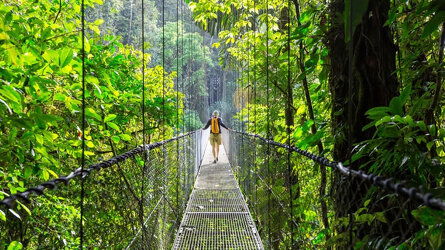
Launching in 1981, Explore offer trips from over 130 countries - from classic small group tours. Read more
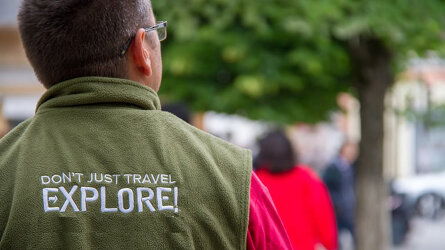
Explore's leaders are more than just your typical guide. They're your local expert are are passionate about sharing their expertise with you. Read more
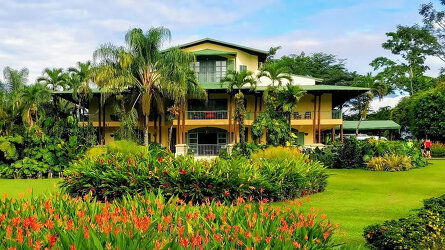
The places Explore stay are every bit as important as the sights they visit and the things you do. Read more

Launching in 1981, Explore offer trips from over 130 countries - from classic small group tours. Read more

Explore's leaders are more than just your typical guide. They're your local expert are are passionate about sharing their expertise with you. Read more

The places Explore stay are every bit as important as the sights they visit and the things you do. Read more
Trip Reviews (1) Most Recent 'Adventures in Patagonia with Iguazu Extension' Reviews
The itinerary was amazing encompassing the most breathtaking scenery; Tierra del Fuego and the city of Ushuaia was the conduit to the Beagle Channel and the infamous Cape Horn. Across the border into Chile and Torres del Paine National Park with its snow covered peaks, soaring Condors and abundant wildlife was the perfect backdrop for many a trek. Further north and back into Argentina, the Perito Moreno Glacier was mesmerising as it creaked and groaned and shed its ice into the waters of Lago Agentino. El Chalten was a remote mecca for hikers and climbers and the track to Mt Fitz Roy provided a challenge for those who were brave or a more gentle surprise for those who were not. The Iguazu extension was a complete contrast to the south and we were plunged into tropical jungle and the river itself on one of the many boat tours that ferry you to the base of the falls. It was an unforgettable journey that will inspire us to explore more of this remarkable continent.
Brochure

Explore Small Group Adventures (2024-25)
Brochure

Explore Small Group Adventures (2024-25)
Availability
A definite departure means minimum numbers have been reached for this departure to operate. Your Global Journeys Travel Advisor will check the availability of your departure date when you enquire. Additional savings may apply. We guarantee the lowest price in Australia. T&C’s apply.
Tour & cruises prices are per person. Prices shown have savings applied, are subject to availability and may be withdrawn at any time without notice. Prices and trip information are correct at the time at this point in time, however are subject to confirmation at the time of booking and are subject to change by Explore. For cruise itineraries, cabin images are sourced from Explore. These should be treated as indicative only. Cabin inclusions, upholsteries and room layout may differ to the image(s) shown depending on the ship selected and your sailing dates.
